目标:1.把矩形旋转正。
2.把文字旋转校正。


目标一(旋转正方形)
思路:A.利用寻找边界进行旋转,然后进行ROI提取。
B.利用霍夫变换等寻找直线,主要找到拐点再进行图像变化。
本文利用第一点思路进行。。。

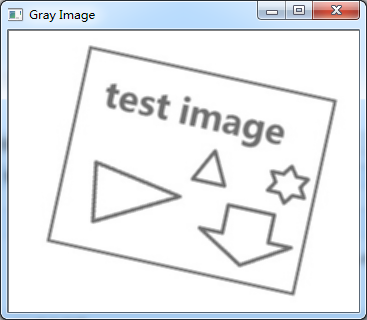
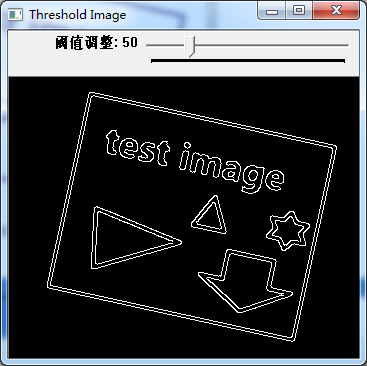

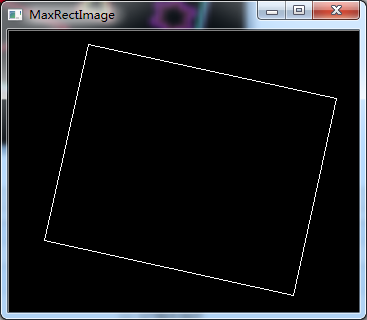
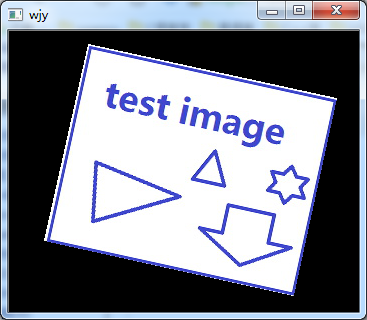


程序很简单,直接上代码:
1 #include<iostream> 2 #include <opencv2/opencv.hpp> 3 #include <math.h> 4 using namespace cv; 5 using namespace std; 6 7 int Threshold_Value = 50; 8 const int Threshold_Max_value = 255; 9 const int Threshold_type_value = 3; 10 double MaxWidth = 0, MaxHeight = 0;//找最大的矩形边 11 12 RNG rng(12345); 13 14 Mat input_image, threshold_image, output_image, Middle_image; 15 16 void Threshold_Image_Bar(int, void *); 17 18 int main(int argc, char**argv) 19 { 20 input_image = imread("1.jpg"); 21 if (input_image.data == NULL) { 22 return -1; cout << "can't open image.../"; 23 } 24 imshow("Sourse Image", input_image); 25 blur(input_image, Middle_image,Size(3,3),Point(-1,-1),4); 26 imshow("Blur Image", Middle_image); 27 cvtColor(Middle_image, Middle_image,COLOR_RGB2GRAY); 28 imshow("Gray Image", Middle_image); 29 namedWindow("Threshold Image",1); 30 createTrackbar("阈值调整", "Threshold Image",&Threshold_Value,255,Threshold_Image_Bar); 31 Threshold_Image_Bar(0,0); 32 waitKey(0); 33 return 0; 34 } 35 36 void Threshold_Image_Bar(int, void *) 37 { 38 /*--------------------------------------------------------------------------------------------------------------------------*/ 39 /*--------------------------------------------------------------------------------------------------------------------------*/ 40 /*-----------------------------------------------------图像旋转校正---------------------------------------------------------*/ 41 /*--------------------------------------------------------------------------------------------------------------------------*/ 42 /*--------------------------------------------------------------------------------------------------------------------------*/ 43 44 threshold(Middle_image, threshold_image, 90, 255, 3); 45 Canny(threshold_image,threshold_image, Threshold_Value, Threshold_Value*3); 46 imshow("Threshold Image", threshold_image); 47 48 vector<vector<Point>> contours; 49 vector<Vec4i> hireachy; 50 findContours(threshold_image,contours,hireachy, RETR_TREE, CHAIN_APPROX_SIMPLE,Point(-1,-1)); 51 char flag_count = 0; 52 Mat Show_threImage = Mat::zeros(threshold_image.size(),CV_8UC3); 53 RotatedRect MinRect; 54 for (size_t i = 0; i < contours.size(); i++) 55 { 56 const Scalar color = Scalar(rng.uniform(0,255),rng.uniform(0,255),rng.uniform(0,255)); 57 drawContours(Show_threImage,contours,static_cast<int>(i),color,2,8,hireachy,0,Point()); 58 MinRect = minAreaRect(contours[i]); 59 //---------------------找最大的长宽、边界-----------------------------// 60 MaxWidth = MaxWidth > MinRect.size.width ? MaxWidth : MinRect.size.width; 61 MaxHeight = MaxHeight > MinRect.size.height ? MaxHeight : MinRect.size.height; 62 flag_count = ((MaxWidth == MinRect.size.width) || (MaxHeight == MinRect.size.height)) ? static_cast<int>(i) : flag_count; 63 } 64 imshow("Draw_Image_Contours", Show_threImage); 65 //-----------------为了求矩形边角点坐标---------------------// 66 Point2f pt[4]; 67 MinRect = minAreaRect(contours[flag_count]); 68 MinRect.points(pt); 69 Mat MaxRectImage = Mat::zeros(input_image.size(),CV_8UC3); 70 for (size_t i = 0; i < 4; i++) 71 { 72 const Scalar color = Scalar(255,255,255); 73 line(MaxRectImage,Point(pt[i]),Point(pt[(i+1)%4]),color); 74 } 75 imshow("MaxRectImage", MaxRectImage); 76 //------水漫操作,为了就倾斜矩形座位ROI,在这里没作用,就是为了看看而已----// 77 Mat gray; 78 gray.create(input_image.size(), input_image.type()); 79 Rect s = boundingRect(contours[flag_count]); 80 floodFill(MaxRectImage, Point(s.x + s.width / 2, s.y + s.height / 2), Scalar(255, 255, 255)); 81 bitwise_and(input_image, MaxRectImage, gray); 82 imshow("wjy", gray); 83 //--------图像旋转-----------// 84 Mat RotateImage = getRotationMatrix2D(Point2f(input_image.cols / 2, input_image.rows / 2), 90+MinRect.angle, 1.0); 85 warpAffine(input_image, input_image,RotateImage, input_image.size(),1,0,Scalar(255,255,255)); 86 imshow("RotateImage", input_image); 87 88 /*--------------------------------------------------------------------------------------------------------------------------*/ 89 /*--------------------------------------------------------------------------------------------------------------------------*/ 90 /*------------------------------------------------ROI区域进行充满图像操作---------------------------------------------------*/ 91 /*--------------------------------------------------------------------------------------------------------------------------*/ 92 /*--------------------------------------------------------------------------------------------------------------------------*/ 93 94 Mat test; 95 blur(input_image, test, Size(3, 3), Point(-1, -1), 4); 96 cvtColor(test, test, COLOR_RGB2GRAY); 97 MaxWidth = 0; MaxHeight = 0; 98 threshold(test, test, 90, 255, 3); 99 100 Canny(test, test, Threshold_Value, Threshold_Value * 3); 101 findContours(test, contours, hireachy, RETR_TREE, CHAIN_APPROX_SIMPLE, Point(-1, -1)); 102 for (size_t i = 0; i < contours.size(); i++) 103 { 104 const Scalar color = Scalar(rng.uniform(0, 255), rng.uniform(0, 255), rng.uniform(0, 255)); 105 drawContours(test, contours, static_cast<int>(i), color, 2, 8, hireachy, 0, Point()); 106 MinRect = minAreaRect(contours[i]); 107 108 MaxWidth = MaxWidth > MinRect.size.width ? MaxWidth : MinRect.size.width; 109 MaxHeight = MaxHeight > MinRect.size.height ? MaxHeight : MinRect.size.height; 110 flag_count = ((MaxWidth == MinRect.size.width) || (MaxHeight == MinRect.size.height)) ? static_cast<int>(i) : flag_count; 111 } 112 MinRect = minAreaRect(contours[flag_count]); 113 114 /*通过水漫算法找ROI 115 Mat gray; 116 gray.create(input_image.size(), input_image.type()); 117 Rect s = boundingRect(contours[flag_count]); 118 floodFill(MaxRectImage, Point(s.x + s.width / 2, s.y + s.height / 2), Scalar(255, 255, 255)); 119 bitwise_and(input_image, MaxRectImage, gray); 120 imshow("wjy", gray); 121 */ 122 /*通过矩形找ROI 123 Rect bbox = MinRect.boundingRect(); 124 Mat wjy_image = input_image(bbox); 125 imshow("123", wjy_image); 126 */ 127 128 /*通过四个点找ROI*/ 129 MinRect.points(pt); 130 //Mat Result_Image = input_image(Rect(Point2i(100,100), Point2i(250, 250))); 131 Mat Result_Image = input_image(Rect(Point2i(pt[1]),Point2i(pt[3]))); 132 Mat Result_ROI = Result_Image.clone(); 133 imshow("123",Result_ROI); 134 135 }
目标二(旋转文字)
首先介绍一下DFT:
1.我们的图像是代表:空间域+值域。
(1)其中空间域就是像素直接的距离,之前的高斯滤波考虑的就是空间域,距离中心像素越近占的权重就越大(这个不懂去看我的高斯那篇博文)。
(2)其中值域就是像素值,之前的中值滤波考虑的就是像素值。
--->>>我现在想看看这个图像的边缘和纹理特征,也就是想看到图像哪里变化的快,图像的走向等,怎么办?如果是一条曲线,我们能看到线的走向,但是看得不明显,这个大家都知道,求f(x)的微分就可以了,看得不够细再求二阶微分。。。那么图像呢?边缘不就是canny算子求得梯度?sift算法不也是求得细节,其中也用到梯度了。这个时候我们的傅里叶变换就上场了。。。
2.我们的频率域代表:图像的变化率(简单理解梯度)
(1)傅里叶变换就是将图像从空间域--->>>频率域(值域就不说了,后者也包含值域),高频部分代表图像的细节、纹理等,低频部分代表图像的轮廓信息。比如中值滤波在空间域就是平衡那些较高的信号,在频率域就是把高频部分给过滤掉。两者是相互变化而来的,对某个的操作另一个操作也适合。
(2)变换的结果包括实数+复数(x+yi),以后用到的大部分都是将两者结合等于幅值图像显示。
(3)变换的大致意思就是任何一个函数都可以用sinx和cosx来表示,具体去看公式~~我也没太理解。。。
程序还有其它知识点,部分有注释,有部分看不懂的都在其它博客中有讲解!
上代码:
1 #include <opencv2/opencv.hpp> 2 #include <iostream> 3 #include <windows.h> 4 5 using namespace cv; 6 using namespace std; 7 void DFT(Mat& src, Mat& dst); 8 int main(int argc, char**argv) 9 { 10 Mat input_image,output_image; 11 input_image = imread("2.jpg"); 12 if (input_image.data == NULL) { 13 return -1; cout << "can't open image.../"; 14 } 15 DFT(input_image, output_image); 16 17 imshow("input_image2", input_image); 18 imshow("input_image2", output_image); 19 waitKey(0); 20 return 0; 21 } 22 void DFT(Mat& src, Mat& dst123) 23 { 24 Mat dst,wjy = src.clone(); 25 cvtColor(src, src, CV_BGR2GRAY); 26 //----获得有利于DFT变换的尺寸--->>就是扩大成奇数尺寸 27 const int height = getOptimalDFTSize(src.rows); 28 const int width = getOptimalDFTSize(src.cols); 29 //----为扩大的尺寸赋值为0 30 Mat middle_image; 31 copyMakeBorder(src, middle_image, 0, height - src.rows, 0, width - src.cols, BORDER_CONSTANT, Scalar::all(0)); 32 //----DFT变换的结果为:实数+虚数,需要弄一个二通道Mat来存储 33 //Mat channels[] = { Mat_<float>(dst),Mat::zeros(src.size(),CV_32F) }; 34 vector<Mat> channels(2); 35 channels[0] = Mat_<float>(middle_image); 36 Mat temp = Mat::zeros(middle_image.size(), CV_32F); 37 channels[1] = temp; 38 Mat complexI; 39 merge(channels,complexI); 40 dft(complexI, complexI);//DFT变换 41 split(complexI, channels);//分离变换的结果:实数+虚数,两个通道 42 magnitude(channels[0], channels[1], channels[0]);//幅值计算-->>结果在channels[3] 43 dst = channels[0]; 44 //---由于幅值太大无法显示,需要进行尺度(详细看sift算法)变换 45 //---这里使用 M1 = log( M + 1 )进行尺寸缩小 46 dst += Scalar::all(1); 47 log(dst, dst); 48 dst = dst(Rect(0, 0, src.cols, src.rows)); 49 normalize(dst, dst, 0, 255, NORM_MINMAX);//浮点数直接显示不出来(如果是0-1可以显示) 50 dst.convertTo(dst, CV_8UC1); 51 //------频域移动 52 int cx = dst.cols; 53 int cy = dst.rows; 54 Mat top_lf = dst(Rect(Point(0, 0), Point(cx / 2, cy / 2))); 55 Mat top_rt = dst(Rect(Point(cx / 2, 0), Point(cx, cy / 2))); 56 Mat bot_lf = dst(Rect(Point(0, cy/2 ), Point(cx/2 , cy))); 57 Mat bot_rt = dst(Rect(Point(cx/2 , cy/2 ), Point(cx, cy))); 58 Mat mid; 59 //top_left<<--->>bottom_right 60 top_lf.copyTo(mid); 61 bot_rt.copyTo(top_lf); 62 mid.copyTo(bot_rt); 63 //top_right<<--->>bottom_left 64 top_rt.copyTo(mid); 65 bot_lf.copyTo(top_rt); 66 mid.copyTo(bot_lf); 67 //直线检测 68 //cvtColor(dst, dst, CV_BGR2GRAY); 69 threshold(dst, dst, 150, 255, THRESH_BINARY_INV); 70 //---此处不适合用houlinesP(),因为斜率在计算很麻烦 71 /*vector<Vec4i> lines; 72 HoughLinesP(dst, lines, 1, CV_PI / 360, 15, 3, 5); 73 Mat LineImage = Mat::zeros(dst.size(), dst.type()); 74 for (size_t i = 0; i < lines.size(); i++) 75 { 76 line(LineImage, Point(lines[i][0], lines[i][1]), Point(lines[i][2], lines[i][3]), Scalar(200, 55, 205), 1, 8, 0); 77 }*/ 78 // 霍夫变换 79 vector<Vec2f> lines; 80 HoughLines(dst, lines, 1, CV_PI / 180, 100, 50, 0); 81 // 检测线个数 82 std::cout << "lines.size:" << lines.size() << std::endl; 83 Mat houghMat(dst.size(), CV_8UC3); 84 houghMat.setTo(0); 85 //for (size_t i = 0; i < lines.size(); i++) 86 // // 绘制检测线 87 //{ 88 // float rho = lines[i][0], theta = lines[i][1]; 89 // Point pt1, pt2; 90 // double a = cos(theta), b = sin(theta); 91 // double x0 = a*rho, y0 = b*rho; 92 // pt1.x = cvRound(x0 + 1000 * (-b)); 93 // pt1.y = cvRound(y0 + 1000 * (a)); 94 // pt2.x = cvRound(x0 - 1000 * (-b)); 95 // pt2.y = cvRound(y0 - 1000 * (a)); 96 // line(houghMat, pt1, pt2, Scalar(0, 255, 0), 1, CV_AA); 97 //} 98 //cv::imshow("houghMat", houghMat); 99 float theta = 0; 100 // 检测线角度判断 101 for (size_t i = 0; i < lines.size(); i++) 102 { 103 float thetaTemp = lines[i][1] * 180 / CV_PI; 104 if (thetaTemp > 0 && thetaTemp < 90) 105 { 106 theta = thetaTemp; 107 break; 108 } 109 } 110 // 角度转换--具体见另一篇博客霍夫变换 111 float angelT = src.rows* tan(theta / 180 * CV_PI) / src.cols; 112 theta = atan(angelT) * 180 / CV_PI; 113 std::cout << "theta:" << theta << std::endl; 114 115 // 取图像中心 116 cv::Point2f centerPoint = cv::Point2f(wjy.cols / 2, wjy.rows / 2); 117 double scale = 1; 118 // 计算旋转矩阵 119 cv::Mat warpMat = getRotationMatrix2D(centerPoint, theta, scale); 120 // 仿射变换 121 cv::Mat resultImage(wjy.size(), wjy.type()); 122 cv::warpAffine(wjy, resultImage, 123 warpMat, resultImage.size()); 124 resultImage.copyTo(dst123); 125 }
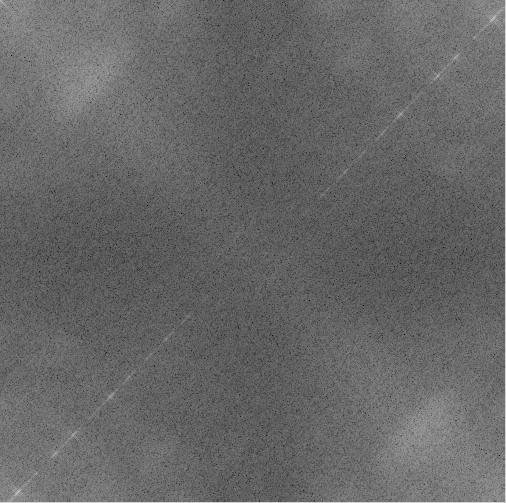
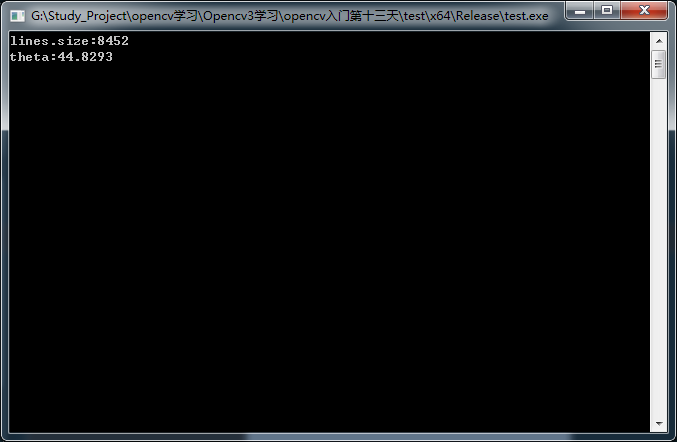
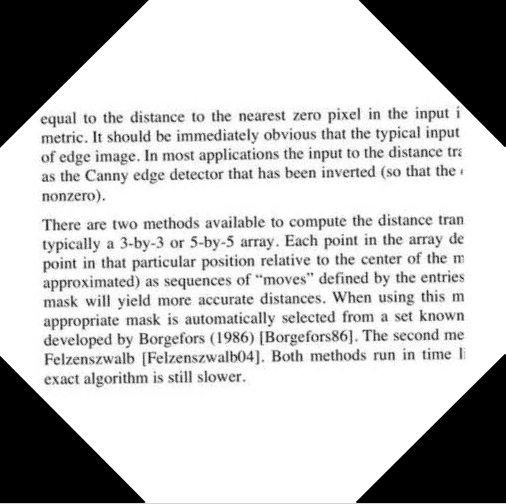
参考: 贾老师opencv系列
《opencv图像处理编程实例》
http://open.163.com/movie/2013/3/K/8/M8PTB0GHI_M8RJ8VMK8.html讲解傅里叶变换的公开课